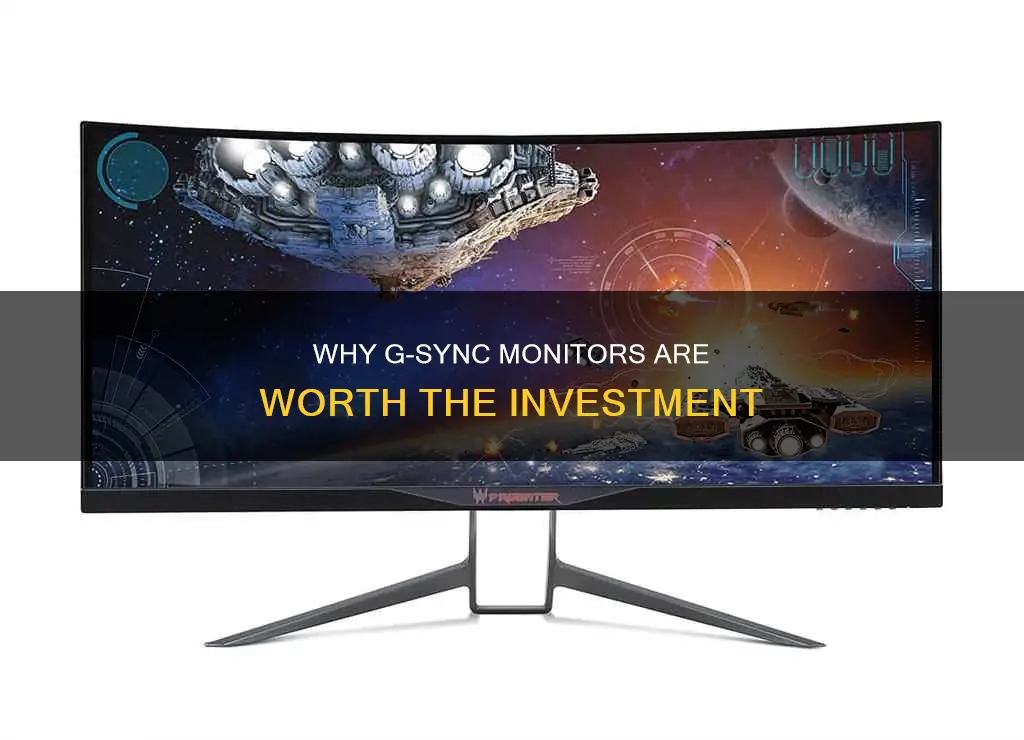
If you're a gamer, you may have heard of G-Sync, an adaptive sync technology developed by Nvidia. But is it worth investing in a G-Sync monitor?
G-Sync is designed to eliminate screen tearing, which occurs when your graphics card produces frames at a rate that doesn't sync with your screen's refresh rate. This technology adjusts your monitor's refresh rate to stay in sync with your GPU's framerate, reducing screen tearing and improving your gaming experience.
However, G-Sync monitors are often more expensive than their FreeSync or G-Sync Compatible alternatives, as they feature a proprietary hardware module. While G-Sync is reliable and compatible with most GPUs and chipsets (except AMD), the high price may be a deal-breaker for budget-conscious gamers.
Ultimately, the decision to buy a G-Sync monitor depends on your specific needs and budget. If you're looking for a tear-free gaming experience and don't mind the extra cost, G-Sync could be worth considering. However, if you're on a tighter budget, there are cheaper alternatives that offer similar performance.
| Characteristics | Values |
|---|---|
| Purpose | Eliminate screen tearing without causing a performance hit |
| Technology | Variable refresh rate (VRR) |
| Cost | More expensive than FreeSync or G-Sync Compatible alternatives |
| Compatibility | Works with NVIDIA GPU of 600-series or later; does not work with AMD chipsets |
| Performance | No noticeable performance hit or input delay |
| Alternative | FreeSync monitors are cheaper but offer comparable performance |
| Decision factors | Resolution, refresh rate, budget, PC configuration |
What You'll Learn
- G-Sync's value depends on your PC configuration and budget
- G-Sync is a specialised technology for a niche use case
- G-Sync is a hardware-based solution, which increases the price of the display
- G-Sync is reliable, efficient, and nearly universal, but it won't work with AMD chipsets
- G-Sync Compatible monitors are designed for NVIDIA GPUs and use the Adaptive Sync standard

G-Sync's value depends on your PC configuration and budget
The value of G-Sync depends on your PC configuration and budget. G-Sync is NVIDIA's take on variable refresh rate (VRR) technology, which is designed to eliminate screen tearing without causing a performance hit. It is not the only VRR technology available, but it has become recognised as somewhat of a gold standard.
G-Sync monitors are often more expensive than their FreeSync or 'G-Sync Compatible' alternatives because they have a proprietary hardware module built into the screen that helps your GPU control the monitor's refresh rate. This module also increases the monitor's price.
If you are looking for a budget gaming monitor, G-Sync may add too much to the price. However, if you want the best 'future-proof' setup you can get, then buying into G-Sync is a smart investment.
Another factor to consider is that G-Sync will not work with AMD graphics cards, so if you have AMD or plan to go down this route, do not buy a G-Sync monitor. AMD graphics cards use a different adaptive sync technology called FreeSync, which is open-source and therefore reduces the cost.
In summary, the value of G-Sync depends on your PC configuration, budget, and whether you plan to use AMD or NVIDIA graphics cards. If you are looking for a budget option or plan to use AMD graphics cards, then FreeSync may be a better option. However, if you want the best possible VRR experience or a 'future-proof' setup, then G-Sync may be worth the investment.
Connecting LG Monitor to MacBook Air: A Simple Guide
You may want to see also

G-Sync is a specialised technology for a niche use case
G-Sync is a technology developed by NVIDIA, designed to eliminate screen tearing without causing a performance hit. It is an adaptive sync technology, which helps to regulate the refresh rate going into the monitor to keep things running smoothly. This is necessary because GPUs can vary their refresh rate from moment to moment, and if this gets out of sync with the monitor's refresh rate, screen tearing can occur.
G-Sync is a hardware-based solution, with a physical module inside the monitor that drives up the price of the display. This is the main downside of G-Sync, as cheaper monitors with similar capabilities are available. For example, AMD's FreeSync technology works in a similar way to G-Sync but does not increase the cost of the monitor.
G-Sync is, therefore, a good choice for people who want to avoid screen tearing but don't want to invest in expensive hardware upgrades. If you can afford to buy a more powerful GPU that can improve your frames per second enough to make tearing imperceptible, then G-Sync is not necessary.
Additionally, G-Sync will not work with AMD chipsets as it is proprietary to NVIDIA. This further limits the technology's use cases.
Overall, G-Sync is a good choice for people who want to balance performance, input lag, and cost, but it is not a necessity for most gamers.
Monitoring Water Usage: Efficient Daily Tracking Methods
You may want to see also

G-Sync is a hardware-based solution, which increases the price of the display
G-Sync is a hardware-based solution that increases the price of the display. It is a proprietary technology developed by Nvidia to combat screen tearing, stuttering, and juddering, especially during fast-paced games or videos. G-Sync works by synchronizing the refresh rates of a monitor with the frame rates of a GPU, ensuring that the monitor's refresh rate adjusts to stay in sync with the game's framerate. This eliminates screen tearing and provides a smoother gaming experience.
The main reason G-Sync increases the price of the display is because it requires a proprietary hardware module to be built into the screen. This module helps the GPU control the monitor's refresh rate and ensures that the two remain synchronized. The inclusion of this module adds to the cost of the display, making G-Sync monitors more expensive than their FreeSync or 'G-Sync Compatible' alternatives.
In addition to the hardware module, G-Sync also utilizes a proprietary board that replaces the typical scaler board found in most displays. This board contains 768MB of DDR3 memory and is used to store the previous frame, allowing it to be compared to the next incoming frame to decrease input lag. The use of this proprietary board further contributes to the increased price of G-Sync displays.
While G-Sync offers a high-quality VRR experience and is known for its consistent performance, it is important to note that it is not the only option available. FreeSync, developed by AMD, is an alternative technology that also aims to eliminate screen tearing. FreeSync monitors are generally cheaper than G-Sync monitors because they do not require the same proprietary hardware. They utilize the open and free Adaptive Sync standard, which results in lower implementation costs.
Ultimately, the decision to invest in a G-Sync display depends on individual needs and budget. G-Sync provides a reliable and consistent VRR experience but comes at a higher price. FreeSync offers a similar feature set but at a more affordable cost. It is essential to consider the specific use case, budget constraints, and the desired level of performance when deciding between G-Sync and its alternatives.
The Evolution of LCD Monitors: A Historical Perspective
You may want to see also

G-Sync is reliable, efficient, and nearly universal, but it won't work with AMD chipsets
G-Sync is a reliable and efficient technology for eliminating screen tearing without causing a performance hit. It is widely recognised as the gold standard in variable refresh rate (VRR) technology, ensuring that screen tearing does not occur. G-Sync monitors feature a proprietary hardware module built into the screen, which allows the monitor's refresh rate to be synchronised with the framerate being outputted by the GPU, resulting in a tear-free gaming experience.
However, G-Sync monitors are often more expensive than their FreeSync or 'G-Sync Compatible' alternatives due to the inclusion of this hardware module. Additionally, G-Sync technology is proprietary to NVIDIA, and while recent G-Sync monitors are compatible with AMD cards, it is because these monitors now support Adaptive Sync, an open standard VRR technology that can be used by AMD cards. If you want to utilise the full G-Sync technology with the hardware module, you will need an NVIDIA GPU of the 600-series or later.
For AMD users, FreeSync or G-Sync Compatible monitors are the recommended options, as they utilise the free and open Adaptive Sync standard, offering comparable performance to full NVIDIA G-Sync technology at a more affordable price point. While G-Sync is a reliable and efficient solution for tear-free gaming, its compatibility with AMD chipsets is limited, making it inaccessible to a significant portion of gamers who prefer AMD hardware.
Understanding Monitor Panels: Identifying Your Display's Type
You may want to see also

G-Sync Compatible monitors are designed for NVIDIA GPUs and use the Adaptive Sync standard
G-Sync Compatible monitors are designed for use with NVIDIA GPUs and are based on the Adaptive Sync standard. This means that, unlike G-Sync monitors, they do not require a proprietary hardware module built into the screen to control the monitor's refresh rate. Instead, they rely on the open Adaptive Sync standard, which is royalty-free and can be used by AMD cards. This makes G-Sync Compatible monitors a more affordable option for those seeking the benefits of variable refresh rate (VRR) technology without the added cost of proprietary hardware.
G-Sync Compatible monitors have been certified by NVIDIA to work well with G-Sync and provide a tear-free gaming experience. They offer comparable performance to full NVIDIA G-Sync technology at a more affordable price point. However, it is important to note that G-Sync Compatible monitors may not support all the features of G-Sync, such as ultra-low motion blur, overclocking, and variable overdrive. Additionally, while G-Sync Compatible monitors support VRR at high refresh rates, some may not offer the same level of support at very low refresh rates as G-Sync monitors.
The decision to choose a G-Sync Compatible monitor depends on your specific needs and budget. If you are an NVIDIA GPU user seeking a cost-effective solution for screen tearing issues, a G-Sync Compatible monitor could be a suitable option. However, if you require the full suite of features and capabilities offered by G-Sync, or if you have an AMD GPU, you may need to consider alternative options.
It is worth noting that the choice between G-Sync and its alternatives, such as FreeSync or G-Sync Compatible, ultimately depends on various factors, including your PC configuration, budget, resolution, refresh rate, and other monitor features you prioritize. While G-Sync provides a consistent and high-quality VRR experience, the increasing quality of Adaptive Sync monitors makes them a competitive choice for many users.
Bloomberg's Monitor Setup: Size and Configuration Explained
You may want to see also
Frequently asked questions
G-Sync is NVIDIA's take on variable refresh rate (VRR) technology, designed to eliminate screen tearing without causing a performance hit.
G-Sync is often worth it, but it depends on your budget and what type of games you play. G-Sync monitors are more expensive than their FreeSync or 'G-Sync Compatible' alternatives.
Screen tearing occurs when your graphics card churns out frames at a rate that doesn't sync with your screen's refresh rate. This results in the monitor attempting to draw a new frame midway through drawing the previous one, causing two frames to be displayed next to each other.
G-Sync uses an NVIDIA hardware scaler module inside the monitor to help control its refresh rate. When paired with NVIDIA G-Sync software, a compatible GPU will use the monitor's scaler module to adjust its refresh rate to stay synchronised with the framerate outputted by the GPU.
No, G-Sync will not work with AMD chipsets. NVIDIA and AMD are rivals, and G-Sync is a proprietary technology developed by NVIDIA.







